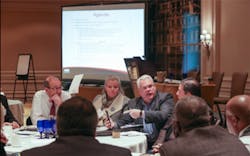NFPA and ASIS hold Active Shooter response strategy meeting
More than 100 experts from the security, fire, law enforcement, EMS, life safety, professional associations and government fields met in Arlington, Va., in late January to discuss active shooting incidents. The meeting, coordinated by the National Fire Protection Association (NFPA) and ASIS International (ASIS), focused on existing resources, the crossover between security and fire disciplines, operational solutions, management procedures, building design and construction issues, and cost considerations with an emphasis on preparation and planning.
The intent of the collaborative effort was, and will continue to be, to examine gaps and exchange knowledge as they relate to active shooter events.
“There is no simple solution to the problem of active shooters, but by convening some of the leading minds on this subject, we hope to create scalable guidance to minimize the likelihood and consequences of these events,” Dr. Marc Siegel, commissioner of the ASIS Intl. Global Standards Initiative, said in a statement.
“By bringing together members of the security and fire safety communities, ASIS and NFPA are taking important steps to define strategies that will protect people as well as physical assets,” added Robert Solomon, NFPA’s division manager for Building Fire Protection and Life Safety, NFPA. “Gathering the best practices from stakeholders and influencers will allow us to formulate necessary guidance so that individuals and organizations can mitigate, survive and recover from these incidents.”
Dr. Siegel reiterated to the group that most situations are over in 10-15 minutes. “What we are doing is buying time to survive an incident until law enforcement arrives,” he told the group.
According to the official meeting notes, discussion ensued relative to the number of areas to consider — i.e. school/workplace violence involving fire, door locking issues, building fire alarm systems and access, first responder, fire emergency management services etc. and that in most instances the events are over by the time the first responders arrive.
The meeting participants deliberated different topics in breakout groups to examine operational solutions, management procedures, building design/construction issues, and process and cost considerations, with an emphasis on planning.
Topics included:
- legal, regulatory and litigation issues;
- conflicts between security, safety and fire safety practices;
- security issues related to active shooter events (proactive and reactive);
- key players and roles of the public and private sector;
- the role of management and technology solutions;
- budgetary and management constraints and concerns;
- gaps and potential improvements in risk assessment and management;
- prevention, preparation and mitigation;
- on‐site and first responder response;
- continuity and recovery;
- awareness;
- exercises and training; and
- minimizing consequences.
It was noted that active shooter response can be promoted to push life safety. “A potential approach to try is to make the policy maker aware that it is the right thing to do — not necessarily the most cost-effective thing to do,” explained Ken Willette, NFPA Division Manager, Public Fire Protection.
Leveraging security technology, such as cameras and mass notification, was also a critical component.
Willette’s breakout group at the meeting determined that stakeholders should build a platform, and develop an active shooter resource, such as a guidance document for people to point to and apply in a tangible manner and with flexibility. Key stakeholders include senior management, first responders, federal agencies, and industry groups such as ASIS and NFPA.
The group concluded that there is not a one-size-fits-all solution, and identified a need for guidance that can be tailored to the conditions and resource constraints of a wide range of organizations.
This effort will continue in future meetings and discussions. “ASIS and NFPA look forward to working together in the area of active shooter response, along with experts from across the spectrum of security, fire and safety in an effort to develop tools for organizations of any size and sector, to best protect human life and physical assets,” the meeting notes concluded.
To read the full meeting notes, please visit www.asisonline.org/Standards-Guidelines/Standards/Pages/Active-Shooter.aspx. Security practitioners and organizations interested in receiving additional information on this initiative should contact [email protected].
About the Author
Paul Rothman
Editor-in-Chief/Security Business
Paul Rothman is Editor-in-Chief of Security Business magazine. Email him your comments and questions at [email protected]. Access the current issue, full archives and apply for a free subscription at www.securitybusinessmag.com.

